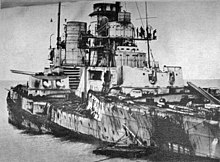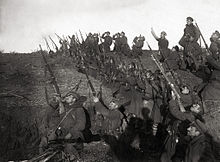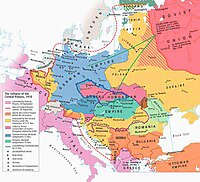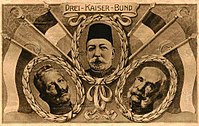Central Powers
Central Powers | |||||||||||
|---|---|---|---|---|---|---|---|---|---|---|---|
| 1914–1918 | |||||||||||
 The Central Powers of Europe on 15 October 1915
Principal Central Powers:
| |||||||||||
| Status | Military alliance | ||||||||||
| Historical era | World War I | ||||||||||
• Established | 1914 | ||||||||||
| 1918 | |||||||||||
| |||||||||||
The Central Powers, also known as the Central Empires,[1][notes 1] were one of the two main coalitions that fought in World War I (1914–1918). It consisted of the German Empire, Austria-Hungary, the Ottoman Empire, and Bulgaria; this was also known as the Quadruple Alliance.[2][notes 2]
The Central Powers' origin was the alliance of Germany and Austria-Hungary in 1879. Despite having nominally joined the Triple Alliance before, Italy did not take part in World War I on the side of the Central Powers. The Ottoman Empire and Bulgaria did not join until after World War I had begun. The Central Powers faced, and were defeated by, the Allied Powers, which themselves had formed around the Triple Entente.
Member states
At the start of the war, the Central Powers consisted of the German Empire and the Austro-Hungarian Empire. The Ottoman Empire joined later in 1914, followed by the Kingdom of Bulgaria in 1915. The name "Central Powers" is derived from the location of these countries; all four were located between the Russian Empire in the east and France and the United Kingdom in the west.

- Allied and Central Powers during World War I
- Allied Powers
- Allied colonies, dominions, territories or occupations
- Central Powers
- Central Powers' colonies or occupations
- Neutral countries

| Principal Nations | Entered WWI |
|---|---|
| 28 July 1914 | |
| 1 August 1914 | |
| 2 August 1914 (secretly) 29 October 1914 (publicly) | |
| 14 October 1915 |
Major Combatants
German Empire
War justifications



In early July 1914, in the aftermath of the assassination of Austro-Hungarian
In August 1914, Germany attacked Russia, citing Russian aggression as demonstrated by the mobilization of the Russian army, which had resulted in Germany mobilizing in response.[6]
After Germany declared war on Russia, France, with its alliance with Russia, prepared a general mobilization in expectation of war. On 3 August 1914, Germany responded to this action by declaring war on France.[7] Germany, facing a two-front war, enacted what was known as the Schlieffen Plan, which involved German armed forces moving through Belgium and swinging south into France and towards the French capital of Paris. This plan was hoped to quickly gain victory against the French and allow German forces to concentrate on the Eastern Front. Belgium was a neutral country and would not accept German forces crossing its territory. Germany disregarded Belgian neutrality and invaded the country to launch an offensive towards Paris. This caused Great Britain to declare war against the German Empire, as the action violated the Treaty of London that both nations signed in 1839 guaranteeing Belgian neutrality.
Subsequently, several states declared war on Germany in late August 1914, with
Colonies and dependencies
In Europe
After successfully beating France in the Franco-Prussian War, the German Empire incorporated the province of Alsace-Lorraine upon its founding in 1871. However, the province was still claimed by French revanchists,[8][9] leading to its recession to France at the Treaty of Versailles.
Africa
The German Empire was late to colonization, only beginning overseas expansion in the 1870s and 1880s. Support for colonization was opposed by much of the government, including chancellor Otto von Bismarck, but it became a colonial power after participating in the Berlin Conference. Then, private companies were founded and began settling parts of Africa, the Pacific, and China. Later these groups became German protectorates and colonies.
Cameroon was a German colony existing from 1884 until its complete occupation in 1915. It was ceded to France as a League of Nations Mandate at the war's end.
German East Africa was founded in 1885 and expanded to include modern-day Tanzania (except Zanzibar), Rwanda, Burundi, and parts of Mozambique. It was the only German colony to not be fully conquered during the war, with resistance by commander Paul von Lettow-Vorbeck lasting until November 1918. Later it was surrendered to the Allies in 1919 and split between the Belgian Congo, Portuguese Mozambique, and the newly founded colony of Tanganyika.
South West Africa, modern-day Namibia, became under German rule in 1885 and was absorbed into South Africa following its invasion in 1915. Members of the local German army and police fought with South Africans seeking independence in the Maritz Rebellion.
Togoland, now part of Ghana, was made a German protectorate in 1884. However, after a swift campaign, it was occupied by the Allies in 1915 and divided between French Togoland and British Togoland.
Asia
The
Pacific
German New Guinea was a German protectorate in the Pacific. It was occupied by Australian forces in 1914.
German Samoa was a German protectorate following the Tripartite Convention. It was occupied by the New Zealand Expeditionary Force in 1914.
Austria-Hungary


War justifications
Austria-Hungary regarded the assassination of
Russia had warned Austria-Hungary that the Russian government would not tolerate Austria-Hungary invading Serbia.[10] However, with Germany supporting Austria-Hungary's actions, the Austro-Hungarian government hoped that Russia would not intervene and that the conflict with Serbia would remain a regional conflict.[3]
Austria-Hungary's invasion of Serbia resulted in Russia declaring war on the country, and Germany, in turn, declared war on Russia, setting off the beginning of the clash of alliances that resulted in the World War.
Territory
Austria-Hungary was internally divided into two states with their own governments, joined through the Habsburg throne. Austria, also known as
Ottoman Empire


War justifications
The Ottoman Empire joined the war on the side of the Central Powers in November 1914. The Ottoman Empire had gained strong economic connections with Germany through the Berlin-to-Baghdad railway project that was still incomplete at the time.
After pressure escalated from the German government demanding that the Ottoman Empire fulfill its treaty obligations, or else Germany would expel the country from the alliance and terminate economic and military assistance, the Ottoman government entered the war with the recently acquired cruisers from Germany, the Yavuz Sultan Selim (formerly SMS Goeben) and the Midilli (formerly SMS Breslau) launching a naval raid on the Russian port of Odesa, thus engaging in military action in accordance with its alliance obligations with Germany. Russia and the Triple Entente declared war on the Ottoman Empire.[14]
Bulgaria
War justifications

Bulgaria was still resentful after its
Declarations of war
| Date | Declared by | Declared against |
|---|---|---|
| 1915 | ||
| 14 October | ||
| 15 October | ||
| 16 October | ||
| 19 October | ||
| 1916 | ||
| 1 September | ||
| 1917 | ||
| 2 July | ||
Co-belligerents
This section needs additional citations for verification. (January 2022) |

South African Republic
In opposition to offensive operations by
Senussi Order

The
Sultanate of Darfur

In 1915 the
Zaian Confederation
The Zaian Confederation began to fight against France in the Zaian War to prevent French expansion into Morocco. The fighting lasted from 1914 and continued after the First World War ended, to 1921. The Central Powers (mainly the Germans) began to attempt to incite unrest to hopefully divert French resources from Europe.
Dervish State
The
Client states
With the Bolshevik attack of late 1917, the General Secretariat of Ukraine sought military protection first from the Central Powers and later from the armed forces of the Entente.
The Ottoman Empire also had its own allies in
German client states
Poland
The Kingdom of Poland was a client state of Germany proclaimed in 1916 and established on 14 January 1917.[18] This government was recognized by the emperors of Germany and Austria-Hungary in November 1916, and it adopted a constitution in 1917.[19] The decision to create a Polish State was taken by Germany in order to attempt to legitimize its military occupation amongst the Polish inhabitants, following upon German propaganda sent to Polish inhabitants in 1915 that German soldiers were arriving as liberators to free Poland from subjugation by Russia.[20] The German government utilized the state alongside punitive threats to induce Polish landowners living in the German-occupied Baltic territories to move to the state and sell their Baltic property to Germans in exchange for moving to Poland. Efforts were made to induce similar emigration of Poles from Prussia to the state.[21]
Ober Ost
Ober Ost was a German client state created in October 1915. It was later turned into other client states in early 1918.
Lithuania
The Kingdom of Lithuania was a client state of Germany created on 16 February 1918.
Belarus
The Belarusian Democratic Republic was a client state of Germany created on 9 March 1918.
Ukraine
The
Crimea
The Crimean Regional Government was a client state of Germany created on 25 June 1918. It was officially part of the Ukrainian State but acted separate from the central government. The Kuban People's Republic eventually voted to join the Ukrainian State.
Courland and Semigallia
The Duchy of Courland and Semigallia was a client state of Germany created on 8 March 1918.
Baltic State
The
Finland
Finland had been an autonomous Grand Duchy within the Russian Empire since 1809, and the collapse of the Russian Empire in 1917 gave it its independence. Following the end of the Finnish Civil War, in which Germany supported the "Whites" against the Soviet-backed labour movement, in May 1918, there were moves to create a Kingdom of Finland. A German prince was elected. However, the Armistice intervened.
Georgia
The Democratic Republic of Georgia declared independence in 1918 which then led to border conflicts between the newly formed republic and the Ottoman Empire. Soon after, the Ottoman Empire invaded the republic and quickly reached Borjomi. This forced Georgia to ask for help from Germany, which they were granted. Germany forced the Ottomans to withdraw from Georgian territories and recognize Georgian sovereignty. Germany, Georgia and the Ottomans signed a peace treaty, the Treaty of Batum which ended the conflict with the last two. In return, Georgia became a German "ally". This time period of Georgian-German friendship was known as German Caucasus expedition.
Don
The Don Republic was founded on 18 May 1918. Their ataman Pyotr Krasnov portrayed himself as willing to serve as a pro-German warlord.
Ottoman client states
Jabal Shammar
Azerbaijan
In 1918, the
Mountain Republic
The Mountainous Republic of the Northern Caucasus was associated with the Central Powers.
Qatar
see also:Qatar in World War I
Initially an Ottoman puppet, Qatar held an Ottoman garrison even following it's independence from the Ottomans in 1913. Following a treaty with Britain, it became a British puppet. It's Ottoman Garrison left prior to this on August 20th, 1915.[25]
Yemen
Yemen Vilayet or Yemen was an autonomous region of the Ottoman Empire that stayed allied with the Sultan and fought against the Allies during the South Arabian campaign.[26]
Nations supported by the Central Powers
States listed in this section were not officially members of the Central Powers. Still, during the war, they cooperated with one or more Central Powers members on a level that makes their neutrality disputable.
Ethiopia
The
Fearing the rising influence of Iyasu and the Ottoman Empire, the Christian nobles of Ethiopia conspired against Iyasu over 1915. Iyasu was first excommunicated by the
Liechtenstein
from 1914 to 1918Liechtenstein was officially neutral throughout World War I, though the general population and government was supportive of the Central Powers, particularly Austria-Hungary, of which the two countries had been in a customs union since 1852. However, from September 1914 food deliveries from Austria-Hungary began to decrease, which quickly soured the initial war support.[28] By 1916 all food deliveries from Austria-Hungary had ceased, which forced Liechtenstein to seek closer ties with Switzerland in order to ensure food deliveries continued.[28][29] From 1916 Liechtenstein was embargoed by the Entente countries due to their connections to the Central Powers, which caused mass unemployment in the country.[30] The government remained sympathetic to the Central Powers until 7 November 1918, when the November 1918 Liechtenstein putsch took place and a new government took power.[31]
Upper Asir
Upper Asir revolted away from Asir in 1916 and fought against them. They were Ottoman-aligned but received support from Hejaz.[32]
Kingdom of Greece
The Kingdom of Greece was in a political dispute with Venizelists. The Central Powers supported the nation until King Constantine's abdication in 1917.[33]
Romania
Following their armistice with the Central Powers, Romania was involved in the Russian Civil War against both the Whites and the Reds. Romania fought alongside the Central Powers until the country rejoined the war against them on November 10th 1918.[34]
Non-state combatants
Other movements supported the efforts of the Central Powers for their own reasons, such as the radical Irish Nationalists who launched the Easter Rising in Dublin in April 1916; they referred to their "gallant allies in Europe". However, most Irish Nationalists supported the British and allied war effort up until 1916, when the Irish political landscape was changing. In 1914, Józef Piłsudski was permitted by Germany and Austria-Hungary to form independent Polish legions. Piłsudski wanted his legions to help the Central Powers defeat Russia and then side with France and the UK and win the war with them.
Armistice and treaties
Bulgaria signed an
|
| |||||||||||||||||||||||||||||||||||||||||||
-
The collapse of the Central Powers in 1918
-
A postcard depicting the flags of the Central Powers' countries
-
Poster for a 1916 charity bazaar raising funds for widows and orphans of the Central Power states
-
The leaders of the Central Powers in 1914
Leaders
Statistics

| Country | Population (millions) |
Land (million km2) |
GDP ($ billion) |
GDP per capita ($) | |
|---|---|---|---|---|---|
| Mainland | 67.0 | 0.5 | 244.3 | 3,648 | |
| Colonies | 10.7 | 3.0 | 6.4 | 601 | |
| Total | 77.7 | 3.5 | 250.7 | 3,227 | |
| 50.6 | 0.6 | 100.5 | 1,980 | ||
| 23.0 | 1.8 | 25.3 | 1,100 | ||
| 4.8 | 0.1 | 7.4 | 1,527 | ||
| Total | 156.1 | 6.0 | 383.9 | 2,459 | |
| Country | Mobilized | Killed in action | Wounded | Missing in action |
Total casualties |
Percentage casualties of total force mobilized |
|---|---|---|---|---|---|---|
| 13,250,000 | 2,037,000 (13.65%) | 6,267,143 | 1,152,800 | 9,456,943 | 71% | |
| 7,800,000 | 1,494,200 (11.82%) | 3,620,000 | 2,200,000 | 7,314,200 | 94% | |
| 3,056,000 | 771,884 (10.84%) | 763,163 | 250,000 | 1,785,000 | 60% | |
| 1,200,000 | 75,844 (6.32%) | 153,390 | 27,029 | 255,263 | 21% | |
| Total | 25,257,321 | 4,378,928 | 10,803,533 | 3,629,829 | 18,812,290 | 75% |
See also
- Central Powers intervention in the Russian Civil War
- Color books, transcripts of official documents released by each nation early in the war
- Diplomatic history of World War I
- Home front during World War I covering all major countries
- International relations of the Great Powers (1814–1919)
- Axis powers
- Kaiserreich (disambiguation)
Footnotes
References
- ^ e.g. in Britain and the Olympic Games, 1908–1920 by Luke J. Harris p. 185
- ^ Hindenburg, Paul von (1920). Out of my life. London : Cassell. p. 113 – via Internet Archive.
- ^ a b c d Cashman, Greg; Robinson, Leonard C. An Introduction to the Causes of War: Patterns of Interstate Conflict from World War I to Iraq. Rowman & Littlefield. 2007. p. 57
- ^ a b c d Meyer, G.J. A World Undone: The Story of the Great War, 1914 to 1918. Delta Book. 2006. p. 39.
- ^ a b Meyer, G.J. A World Undone: The Story of the Great War, 1914 to 1918. Delta Book. 2006. p. 95.
- ^ Hagen, William W. German History in Modern Times: Four Lives of the Nation. p. 228.
- ^ Tucker, Spencer C. A Global Chronology of Conflict: From the Ancient World to the Modern Middle East: From the Ancient World to the Modern Middle East. ABC-CLIO. 2009. p. 1556.
- ^ Seager, Frederic H. (1969). "The Alsace-Lorraine Question in France, 1871-1914". in Charles K. Warner, ed., From the Ancien Régime to the Popular Front, pp 111-126.
- S2CID 193058659.
- ^ a b c Cashman, Greg; Robinson, Leonard C. An Introduction to the Causes of War: Patterns of Interstate Conflict from World War I to Iraq. Rowman & Littlefield. 2007. p. 61
- ^ Hickey, Michael. The First World War: Volume 4 The Mediterranean Front 1914–1923. p. 31.
- ^ a b c Afflerbach, Holger; David Stevenson, David. An Improbable War: The Outbreak of World War 1 and European Political Culture. Berghan Books. 2012. p. 292.
- ^ a b Kent, Mary. The Great Powers and the End of the Ottoman Empire. end ed. Frank Cass. 1998. p. 119
- ^ Afflerbach, Holger; David Stevenson, David. An Improbable War: The Outbreak of World War I and European Political Culture. Berghan Books. 2012. p. 293.
- ^ Hall, Richard C. "Bulgaria in the First World War". Russia's Great War and Revolution. Archived from the original on 23 September 2017. Retrieved 22 September 2017.
- ISBN 978-0-295-96413-3.
- ^ Richard C. Hall, "Bulgaria in the First World War". Historian 73.2 (2011): 300–315.
- ^ The Regency Kingdom has been referred to as a puppet state by Norman Davies in Europe: A history (Google Print, p. 910); by Jerzy Lukowski and Hubert Zawadzki in A Concise History of Poland (Google Print, p. 218); by Piotr J. Wroblel in Chronology of Polish History and Nation and History (Google Print, p. 454); and by Raymond Leslie Buell in Poland: Key to Europe (Google Print, p. 68: "The Polish Kingdom... was merely a pawn [of Germany]").
- ^ J. M. Roberts. Europe 1880–1945. p. 232.
- ^ Aviel Roshwald. Ethnic Nationalism and the Fall of Empires: Central Europe, the Middle East and Russia, 1914–23. Routledge, 2002. p. 117.
- ^ Annemarie Sammartino. The Impossible Border: Germany and the East, 1914–1922. Cornell University, 2010. pp. 36–37.
- ^ Kataryna Wolczuk. The Moulding of Ukraine: The Constitutional Politics of State Formation. p. 37.
- ^ Hala Mundhir Fattah. The Politics of Regional Trade in Iraq, Arabia, and the Gulf, 1745–1900. p. 121.
- ^ a b Zvi Lerman, David Sedik. Rural Transition in Azerbaijan. p. 12.
- .
- ISSN 0361-2759.
- ^ a b "How Ethiopian prince scuppered Germany's WW1 plans". BBC News. 25 September 2016. Retrieved 22 October 2018.
- ^ Historisches Lexikon des Fürstentums Liechtenstein(in German). Retrieved 28 September 2023.
- ISSN 0362-4331. Retrieved 6 October 2023.
- Historisches Lexikon des Fürstentums Liechtenstein(in German). Retrieved 28 September 2023.
- Historisches Lexikon des Fürstentums Liechtenstein(in German). Retrieved 3 October 2023.
- . Retrieved 11 February 2024.
- ISSN 1937-5239.
- ISSN 1584-8051.
- ISBN 978-0-313-38385-4.
- ^ S.N. Broadberry, Mark Harrison. The Economics of World War I. illustrated ed. Cambridge University Press, 2005, pp. 9–10.
- ISBN 978-0-8153-0399-2.
Further reading
- Akin, Yigit. When the War Came Home: The Ottomans' Great War and the Devastation of an Empire (2018)
- Aksakal, Mustafa. The Ottoman Road to War in 1914: The Ottoman Empire and the First World War (2010).
- Brandenburg, Erich. (1927) From Bismarck to the World War: A History of German Foreign Policy 1870–1914 (1927) online.
- Clark, Christopher. The Sleepwalkers: How Europe Went to War in 1914 (2013)
- Craig, Gordon A. "The World War I alliance of the Central Powers in retrospect: The military cohesion of the alliance". Journal of Modern History 37.3 (1965): 336–344.
- Dedijer, Vladimir. The Road to Sarajevo(1966), comprehensive history of the assassination with detailed material on the Austrian Empire and Serbia.
- Fay, Sidney B. The Origins of the World War (2 vols in one. 2nd ed. 1930). online, passim
- Gooch, G. P. Before The War Vol II (1939) pp 373–447 on Berchtold
- Hall, Richard C. "Bulgaria in the First World War". Historian 73.2 (2011): 300–315. online Archived 27 July 2020 at the Wayback Machine
- Hamilton, Richard F. and Holger H. Herwig, eds. Decisions for War, 1914–1917 (2004), scholarly essays on Serbia, Austria-Hungary, Germany, Russia, France, Britain, Japan, Ottoman Empire, Italy, the United States, Bulgaria, Romania, and Greece.
- Herweg, Holger H. The First World War: Germany and Austria-Hungary 1914–1918 (2009).
- Herweg, Holger H., and Neil Heyman. Biographical Dictionary of World War I (1982).
- Hubatsch, Walther. Germany and the Central Powers in the World War, 1914– 1918 (1963) online Archived 16 November 2020 at the Wayback Machine
- Jarausch, Konrad Hugo. "Revising German History: Bethmann-Hollweg Revisited". Central European History 21#3 (1988): 224–243, historiography in JSTOR
- Pribram, A. F. Austrian Foreign Policy, 1908–18 (1923) pp 68–128.
- Rich, Norman. Great Power Diplomacy: 1814–1914 (1991), comprehensive survey
- Schmitt, Bernadotte E. The coming of the war, 1914 (2 vol 1930) comprehensive history online vol 1; online vol 2, esp vol 2 ch 20 pp 334–382
- Strachan, Hew. The First World War: Volume I: To Arms (2003).
- Tucker, Spencer C., ed. The European Powers in the First World War: An Encyclopedia (1996) 816pp
- Watson, Alexander. Ring of Steel: Germany and Austria-Hungary in World War I (2014)
- Wawro, Geoffrey. A Mad Catastrophe: The Outbreak of World War I and the Collapse of the Habsburg Empire (2014)
- Williamson, Samuel R. Austria-Hungary and the Origins of the First World War (1991)
- Zametica, John. Folly and malice: the Habsburg empire, the Balkans and the start of World War One (London: Shepheard–Walwyn, 2017). 416pp.





